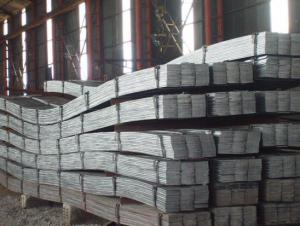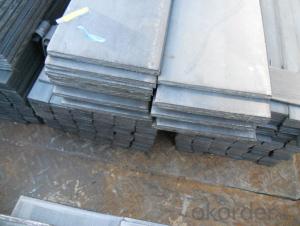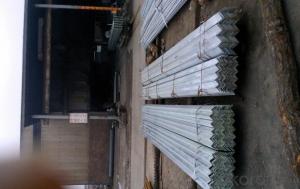Hot Rolled Seel Flat Bars with Best price
- Loading Port:
- Tianjin
- Payment Terms:
- TT OR LC
- Min Order Qty:
- 25 m.t.
- Supply Capability:
- 10000 m.t./month
OKorder Service Pledge
OKorder Financial Service
You Might Also Like
Product Description:
OKorder is offering high quality Flat Bar at great prices with worldwide shipping. Our supplier is a world-class manufacturer of steel, with our products utilized the world over. OKorder annually supplies products to European, North American and Asian markets. We provide quotations within 24 hours of receiving an inquiry and guarantee competitive prices.
Product Applications:
Flat Bars are ideal for structural applications and are widely used in the construction of buildings and bridges, and the manufacturing, petrochemical, and transportation industries.
Product Advantages:
OKorder's Flats Bar are durable, strong, and resist corrosion.
Main Product Features:
· Premium quality
· Prompt delivery & seaworthy packing (30 days after receiving deposit)
· Corrosion resistance
· Can be recycled and reused
· Mill test certification
· Professional Service
· Competitive pricing
Product Specifications:
Manufacture: Hot Rolled
Grade: Q195 – 235 ;SS400
Certificates: ISO, SGS, BV, CIQ
Length: 6m – 12m, as per customer request
Packaging: Export packing, nude packing, bundled
Chemical composition of Q235
Alloy No | Grade | Element(%) | ||||
C
| Mn
| S
| P
| Si
| ||
Q235
|
B
|
0.12—0.20 |
0.3—0.7 |
≤0.045 |
≤0.045
|
≤0.3
|
Physical properties of Q235
Alloy No | Grade | Yielding strength point(Mpa) | Tensile strength (Mpa) | Elongation after fracture(%) | ||||||
Thickness (mm) | Thickness (mm) | |||||||||
≤16 | >16--40 | >40--60 | >60--100 | ≤16 | >16--40 | >40--60 | >60--100 | |||
≥ | ≥ | |||||||||
Q235 |
B |
235 |
225 |
215 |
205 |
375--500 |
26 |
25 |
24 |
23 |
FAQ:
Q1: How soon can we receive the product after purchase?
A1: Within three days of placing an order, we will begin production. The specific shipping date is dependent upon international and government factors, but is typically 7 to 10 workdays.
Q2: How do we guarantee the quality of our products?
A2: We have established an advanced quality management system which conducts strict quality tests at every step, from raw materials to the final product.
Q3: The products are invoicing on theoritical weight or on actual weight basis ?
A3: We can do it in both manners, according to buyers' requirement.
Q4: What is the normal tolerance of flat bars?
A4: Normally 7%-9%, but we can also produce the goods according to the customers' requests.
Images:


- Q: Cold rolled flat steel standard. What is cold rolled flat steel?
- Flat steel, width 12-300mm, thickness 4-60mm, cross section is rectangular and with pure edge of steel. Flat steel can be finished steel, or can be used as the blank of welded pipe and thin slab for laminated sheet rolling.
- Q: How do steel flat bars perform in corrosive or acidic environments?
- Steel flat bars generally perform well in corrosive or acidic environments, but their resistance to corrosion depends on the type of steel used and the specific properties of the environment. Stainless steel flat bars, for example, are highly resistant to corrosion in most acidic or corrosive environments. This is because they contain a minimum of 10.5% chromium, which creates a protective oxide layer on the surface of the steel that prevents further corrosion. Additionally, stainless steel flat bars can be alloyed with other elements such as nickel or molybdenum to enhance their corrosion resistance even further. However, not all steel flat bars are as resistant to corrosion. Carbon steel flat bars, for instance, are susceptible to rust and corrosion in acidic or corrosive environments. This is because they lack the protective oxide layer present in stainless steel. In such cases, additional measures like galvanization or coating the flat bars with corrosion-resistant materials may be necessary to protect them from corrosion. Overall, it is important to consider the specific type of steel used and the nature of the corrosive or acidic environment when determining the performance of steel flat bars in such conditions. Consulting with experts or referring to corrosion resistance charts can provide more specific information on the suitability of steel flat bars in different environments.
- Q: Can steel flat bars be recycled?
- Yes, steel flat bars can be recycled. Steel is one of the most commonly recycled materials in the world due to its high recyclability. When steel flat bars reach the end of their useful life, they can be collected, sorted, and processed at recycling facilities. The recycling process involves melting down the steel bars to remove impurities and shape them into new steel products. This process can be repeated indefinitely without compromising the quality of the steel. Recycling steel flat bars not only helps conserve natural resources but also reduces energy consumption and greenhouse gas emissions associated with the production of new steel.
- Q: How do you determine the length of a steel flat bar?
- To determine the length of a steel flat bar, you can use a measuring tape or ruler and measure from one end to the other in a straight line.
- Q: Are steel flat bars suitable for making electrical enclosures or cabinets?
- Yes, steel flat bars are suitable for making electrical enclosures or cabinets. Steel is a durable and strong material that offers excellent protection and security for electrical components. The flat bars provide a sturdy framework for the enclosure or cabinet, ensuring stability and support. Additionally, steel is resistant to heat, corrosion, and impact, making it an ideal choice for housing electrical equipment. It also has good electrical conductivity, which is crucial in maintaining proper grounding and preventing electrical hazards. Moreover, steel flat bars can be easily customized and fabricated to meet specific size and design requirements, allowing for flexibility in creating the enclosures or cabinets. Overall, steel flat bars are a reliable and practical option for constructing electrical enclosures or cabinets due to their strength, durability, and electrical properties.
- Q: Where can I buy ground level bending machine?
- Galvanized flat steel and galvanized steel (or steel) for welding, reliable connection, should be in addition to the contact regions on both sides of the weld, should also direct the flat curved (or rectangular) and steel (or steel) and steel pipe welding, when welding on the steel pipe wrapped around the welding length 2 times less than the width of flat steel.
- Q: Are steel flat bars suitable for marine environments?
- Yes, steel flat bars are suitable for marine environments as they possess excellent corrosion resistance properties.
- Q: Are steel flat bars easy to work with?
- Yes, steel flat bars are generally easy to work with. They can be cut, bent, drilled, and welded easily, making them suitable for various construction and DIY projects.
- Q: Can steel flat bars be used for making storage systems?
- Indeed, storage systems can be fashioned using steel flat bars. Due to its durability and strength, steel proves to be an appropriate material for fabricating storage systems capable of enduring substantial weights and offering structural reinforcement. Steel flat bars present an opportunity to construct shelves, racks, and frames to accommodate storage systems found in warehouses, retail establishments, or even residential or office spaces. Moreover, steel flat bars can be effortlessly welded, cut, and molded according to precise design prerequisites, rendering them versatile in crafting tailor-made storage resolutions.
- Q: What are the maximum and minimum thicknesses for steel flat bars?
- The thickness of steel flat bars can vary depending on the grade and type of steel used. The specific maximum and minimum thicknesses differ in each case. Generally, steel flat bars can have a maximum thickness range of approximately 10 mm to 150 mm or more, depending on their application and manufacturing capabilities. Conversely, the minimum thickness for steel flat bars can be as thin as 1 mm or even less, depending on the specific requirements and manufacturing processes involved. To determine the exact maximum and minimum thicknesses for a specific steel flat bar, it is crucial to refer to the relevant standards, specifications, or consult with a steel supplier or manufacturer.
Send your message to us
Hot Rolled Seel Flat Bars with Best price
- Loading Port:
- Tianjin
- Payment Terms:
- TT OR LC
- Min Order Qty:
- 25 m.t.
- Supply Capability:
- 10000 m.t./month
OKorder Service Pledge
OKorder Financial Service
Similar products
Hot products
Hot Searches
Related keywords




























